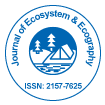Our Group organises 3000+ Global Conferenceseries Events every year across USA, Europe & Asia with support from 1000 more scientific Societies and Publishes 700+ Open Access Journals which contains over 50000 eminent personalities, reputed scientists as editorial board members.
Open Access Journals gaining more Readers and Citations
700 Journals and 15,000,000 Readers Each Journal is getting 25,000+ Readers
Google Scholar citation report
Citations : 2854
Journal of Ecosystem & Ecography received 2854 citations as per Google Scholar report
Journal of Ecosystem & Ecography peer review process verified at publons
Indexed In
- CAS Source Index (CASSI)
- Index Copernicus
- Google Scholar
- Sherpa Romeo
- Online Access to Research in the Environment (OARE)
- Open J Gate
- Genamics JournalSeek
- Ulrich's Periodicals Directory
- Access to Global Online Research in Agriculture (AGORA)
- Electronic Journals Library
- RefSeek
- Hamdard University
- EBSCO A-Z
- OCLC- WorldCat
- SWB online catalog
- Virtual Library of Biology (vifabio)
- Publons
- Geneva Foundation for Medical Education and Research
- Euro Pub
Useful Links
Recommended Journals
Share This Page
Cultural ecosystem services of different landscapes in Ugam Chotqol National Nature Park
Joint Conference International Conference on Environmental Microbiology and Microbial Ecology & International Conference on Ecology and Ecosystems
Madina Bekchanova
Wageningen University, Netherlands
Posters & Accepted Abstracts: J Ecosyst Ecography
Abstract
Landscapes are the main resources of providing the sufficient amount of ecosystem services like the provision of food and material, provision of cultural ecosystem services such as recreation, aesthetics or spirituality. However, cultural ecosystem services are rarely studied and little is known about spatial localization of these services. In this research, a framework is adopted and tested in order to classify and map the provision of cultural ecosystem services as observed by tourists in Ugam Chotqol National Nature Park, i.e. Tashkent region in Uzbekistan. In this study a photo-based questionnaire survey is joined with cartographical images of landscape classes to obtain hot and cold spot provision areas of cultural ecosystem services. Statistical analysis is used to represent influences of the respondents├ó┬?┬? socio- demographic background and land-use type on the tourists├ó┬?┬? perception of these services. According to the results, each of the studied cultural ecosystem services, showed the various spatial patterns on the basis of its distribution and in different landscapes to which they are related. Specifically, traditionally survived areas, located in highlands between 1200 and 3500 m asi are considered as hotspot areas for recreational activities, aesthetic beauty and cultural heritage. While, the lowland plains of the study area mainly provide tourists with the spirituality. Results demonstrate that for the tourist perception the highest influence is obtained from land use type, while other aspects such socio demographic factors (gender, age, cultural background, environmental behaviour) and respondents perceived importance of the services are significant but they play subordinate role. It can be concluded that, spatial information about the provision of cultural ecosystem services can help us to design further implementation of land use policies.Biography
Madina Bekchanova has her skill in evaluation of ecosystem services and motivation of enhancing spatial localization of each component of ecosystem services. Her thesis is based on analyzing Cultural Ecosystem Services (CES) and its association with different landscapes. After having taken sufficient amount of Master courses in Integrated Ecosystem Assessment, she started to write her thesis. Her thesis is mainly for representing the significance of landscapes in the provision of cultural ecosystem services and tourists perception of CES in different landscapes. In order to analyze tourists perception she used econometric model and simultaneously, she used GIS tools to classify various landscapes. This research can be very helpful for decision makers to plan further operations.

 Spanish
Spanish  Chinese
Chinese  Russian
Russian  German
German  French
French  Japanese
Japanese  Portuguese
Portuguese  Hindi
Hindi 
